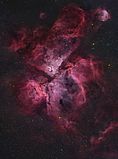NGC 3324
Appearance
| NGC 3324 | |
|---|---|
 | |
| Observation data (J2000 epoch) | |
| Right ascension | 10h 37m 20s[1] |
| Declination | −58° 38′ 30″[1] |
| Distance | 7,560 ly (2,317 pc)[2] |
| Apparent magnitude (V) | 6.7[1][3] |
| Apparent dimensions (V) | 16 arcminutes[3] |
| Physical characteristics | |
| Estimated age | 6.754 Myr[2] |
| Other designations | ESO 128-EN006, Cr 225, Lund 552, h 3286, GC 2167, C 1035-583, OCl 819.0, [KPR2004b] 254, [KPS2012] MWSC 1830 |
| Associations | |
| Constellation | Carina |
NGC 3324 is an open cluster in the southern constellation Carina, located northwest of the Carina Nebula (NGC 3372)[4][5] at a distance of 7,560 ly (2,317 pc) from Earth.[2] It is closely associated with the emission nebula IC 2599, also known as Gum 31.[6] The two are often confused as a single object, and together have been nicknamed the "Gabriela Mistral Nebula" due to its resemblance to the Chilean poet.[3][7][8] NGC 3324 was first catalogued by James Dunlop in 1826.[4]
Gallery
-
The Carina Nebula with NGC 3324 at top right
-
Hubble detail of a western section of NGC 3324 (north is to the right)
References
- ^ a b c "NGC 3324". SIMBAD. Centre de données astronomiques de Strasbourg. Retrieved 2 December 2016.
- ^ a b c Kaltcheva, N. T.; Golev, V. K. (February 2012). "Galactic Structure Toward the Carina Tangent". Publications of the Astronomical Society of the Pacific. 124 (912): 128–139. arXiv:1201.4273. Bibcode:2012PASP..124..128K. doi:10.1086/664697. S2CID 118624276.
- ^ a b c "Gabriela Mistral Nebula · NGC 3324". DSO-Browser.com. Retrieved 2 December 2016.
- ^ a b "NGC 3324". The NGC/IC Project. Archived from the original on 28 May 2009. Retrieved 2 December 2016.
- ^ Cooper, Ian; Kay, Jenni; Kepple, George Robert (2008). The Night Sky Observer's Guide. Volume 3: The Southern Skies. Willmann-Bell. p. 52. ISBN 978-0-943396-89-7.
- ^ "IC 2599". SIMBAD. Centre de données astronomiques de Strasbourg. Retrieved 2 December 2016.
- ^ "A Pocket of Star Formation". European Southern Observatory. 1 February 2012. Photo Release eso1207. Retrieved 2 December 2016.
- ^ Chadwick, Stephen; Cooper, Ian (2012). Imaging the Southern Sky: An Amateur Astronomer's Guide. Patrick Moore's Practical Astronomy Series. New York: Springer Science+Business Media. pp. 81–83. doi:10.1007/978-1-4614-4750-4. ISBN 978-1-4614-4749-8.
External links
 Media related to NGC 3324 at Wikimedia Commons
Media related to NGC 3324 at Wikimedia Commons- NASA Astronomy Picture of the Day: NGC 3324 in Carina (6 April 2018)


